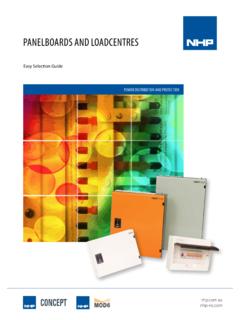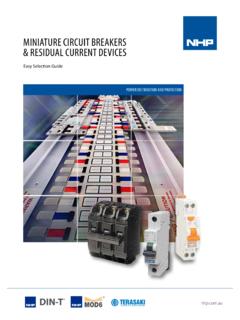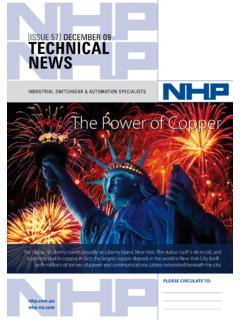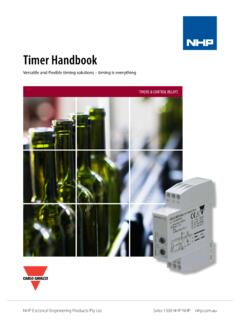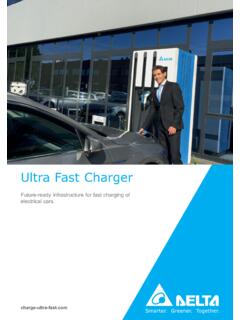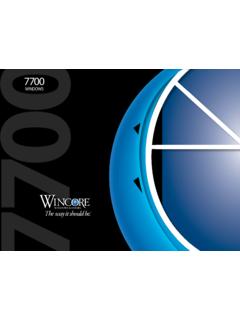Transcription of LIQUID RESISTANCE STARTERS - nhp.com.au
1 LIQUID RESISTANCE rotor motor control for demanding industrial applications from 200 kW to MWmoToR CoNTRoL & DRIVESThe issuesThe torque and current versus speed characteristics of a wound rotor motor can be altered and controlled through the addition of resistances to the rotor circuit. Whilst one of the more common methods for starting wound rotor motors is the multi-stage secondary RESISTANCE starter, it is understood the resistors can generate substantial amounts of heat during starting, provide inconsistent starting performance and require frequent and costly maintenance. Close control of starting torque and current also requires more RESISTANCE stages adding complexity and cost to the motor control system.
2 The solutionWith many systems comprising little more than a tank which holds an electrolytic solution, thermostats and floats to monitor electrolyte temperature and level, and an enclosure which houses a shorting contactor and timer, the simplicity of LIQUID RESISTANCE makes them the ideal proposition for any down time critical plant and/or for remote installations where the availability of specialist electrical personnel may be limited. For these reasons electrical engineers and equipment specifiers have turned their attention to LIQUID RESISTANCE starting of wound rotor motors. ApplicationsSuitable for use with heavy industrial machines such as; ball and SAG mills, crushers, conveyors, compressors, chippers, fans, pumps, mixers and saws Key benefits Simple, easy to understand technology Optimum control over starting current, torque and motor/load acceleration High reliability No need for specialist electrical personnel or equipment Low maintenance Long service life Ideal for down time critical plantIn applications where the driven machine presents a high starting load and/or there is a need to start with absolute minimal current draw, a wound rotor (or slip ring)
3 Motor can provide unparalleled starting offers a range of Australian made and industry proven fixed and moving electrode LIQUID RESISTANCE STARTERS for use with low and medium voltage wound rotor motors from 200 kW to LIQUID RESISTANCE startersAusTrAliAn design And mAnufAcTureDesigned by NHP and manufactured at our national manufacturing and distribution centre at Laverton North, Victoria, the NHP range of LIQUID RESISTANCE STARTERS offer a number of significant advantages. Our STARTERS and the individual components used within them, comply to all applicable codes, directives and Australian standards. NHP s direct involvement in all elements of production from conception through to design and manufacture ensures commercial benefits, a superior level of quality control and consistency of product that promise performance and results you can trust.
4 Whilst our STARTERS are generally manufactured to NHP standard format, they can also be customised to meet customer specification and/or any specific site conditions. Our range of HLR moving electrode STARTERS offers a turn down ratio in excess of 200:1, the highest in the industry. This is achieved via a unique horizontal moving electrode system and delivers the softest possible starts and smoothest transition to run, which, in turn, greatly extend the mechanical life of the motor and driven machine. In line with NHP s end to end solutions promise, is a comprehensive range of value add services that offer round the clock support from a dedicated and proficiently qualified fixed electrode STARTERS are manufactured in Australia and are intended for wound rotor motors applications from 200 kW to 750 kWHlr moving electrode STARTERS are designed and manufactured in Australia and are intended for wound rotor motors from 200 kW to mWImages provided for representative purposes onlyFixed electrode LIQUID RESISTANCE startersm350 sTArTerfor use with low and medium voltage wound rotor motors from 200 kW to 750 kW.
5 Maximum rotor volts = 1500 VOVerVieWThe M350 is a two stage LIQUID RESISTANCE starter, each stage replacing the equivalent of approximately five stages of fixed RESISTANCE . The RESISTANCE units comprise electrodes (either two or three) immersed in electrolyte, contained within a 350 litre stainless steel tank. The number of electrodes used is determined by the kW rating of the motor, the number of starts per hour and the run-up principle of operation is based on the difference in resistivity between the LIQUID electrolyte and its vapour contained in an electrode chamber. The passage of the initial rotor current causes immediate partial vaporisation of the electrolyte and instantaneously adjusts RESISTANCE and starting torque to optimum value.
6 During run-up, the thermal interchange which occurs decreases the RESISTANCE and a timed contactor then short circuits the low residual progressive decrease in RESISTANCE provides smooth and continuous acceleration, hence the motor reaches full speed in the shortest possible time with the absence of mechanical stress. As the RESISTANCE decreases in direct relation to the motor speed, the possibility of operator misuse is minimised and motor burn-out problems are resolved. fleXiBiliTYM350 STARTERS are easily adjustable on-site to meet changes in torque or load. This is achieved by altering the electrolyte speed12341 - direct switch2 - M3503 - 2 step metallic resistance4 - load torqueTorque comparison during startingResistance comparison during startingresistanceResistance decreases during starting1 - 3 step metallic resistance2 - M350122505075100% speed12341 - direct switch2 - M3503 - 2 step metallic resistance4 - load torqueTorque comparison during startingResistance comparison during startingresistanceResistance decreases during starting1 - 3 step metallic resistance2 - M350122505075100% speed4enVirOnmenTAl sTABiliTYA layer of oil is floated on top of the electrolyte to form a seal which not only
7 Minimises evaporation, but eliminates contamination from the cOndiTiOnsWhether in the snow fields, or the desert regions of the outback, M350 STARTERS are operating almost maintenance free. Their only requirement is the need to occasionally top them up with drinking water (pH = 7 to 9) every 12 months or ratings up to 750 kW very quick deliveries can be achieved as all components required for construction are available ex-stock. M350 control circuitM350 power circuitNotes: Nominal ratings only, based on four consecutive starts followed by two starts per hour from hot. Actual ratings will depend on start torque and run up time required.
8 FLT = Full Load Torque otherwise referred to as Motor Rated electrode assembly. One of two or three used in an M350 rATingsM350 STARTERS are designed to meet the starting torque requirements of the application and the starting duty (starting time and starts per hour) specified by the user. The ratings given to M350 STARTERS are therefore variable and application dependant. 5starter model nominal motor kW rating at starting torque of;single motor drives x flT x flT x flT x flT m350/2 500 355 250 185 m350/3 750 650 450 315 OVerVieWThe HLR starter consists of a stainless steel tank containing the electrolyte and electrode assemblies, control cubicles which house the shorting contactor and ancillary control equipment, mounted on and within a galvanized steel frame (no frame for HLR700 and HLR1100 models).
9 Electrode movement is provided by a gear motor and belt drive. A clutch arrangement is used to connect the moving electrode carriage to the belt drive. This prevents damage should the carriage be driven into the end stops, it also eliminates the need for over travel limit the geared motor and belt drive assembly, the variable speed drive controls the rate at which the electrodes move, and in turn, the starting time of the motor. The electrodes move through a horizontal plane to provide a near linear RESISTANCE /travel characteristic. The turn down ratio (ratio of initial to final RESISTANCE ) is typically 200:1 thereby providing smooth starting and an extremely low torque surge on energisation of the rotor shorting contactor.
10 The horizontal movement of the electrodes also acts to agitate the electrolyte thereby eliminating the need for a circulation pump for most standard duty level is monitored by a float switch and starting is prevented if the level is low. A thermostat is also provided to prevent starting if the electrolyte temperature is too high and a thermometer allows actual electrolyte temperature to be monitored. In some cases a circulation pump is combined with a water to water or a water to air heat exchanger to remove heat from the electrolyte. Additions of this nature are required when the starting duty produces more heat than can be dissipated by the tank and in applications that can benefit from limited speed control, for example belt inspection on a conveyor or similar operations on other electrolyte tank is readily accessible for inspection and maintenance via viewing windows and hinged lids.
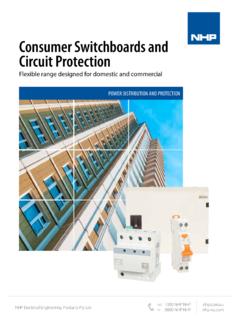
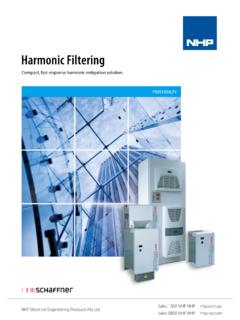
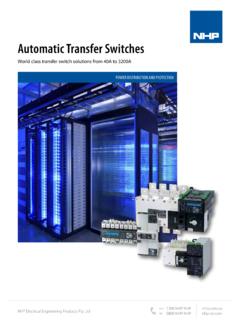
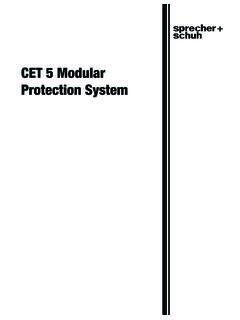
![[CATALOGUE TB2-CAT] TEMBREAK 2 MOULDED …](/cache/preview/6/3/1/3/d/b/b/2/thumb-6313dbb2a06c3f72e0063d5e815c6636.jpg)
